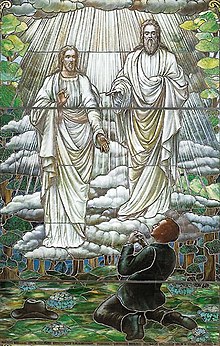Great Apostasy
[2][3][4] These Restorationist groups hold that traditional Christianity, represented by Catholicism, Protestantism and Orthodoxy, has fallen into error and thus, the true faith needs to be restored.
[5] Because it made these changes using claims of tradition and not from scripture, the Church – in the opinion of those adhering to this concept – has fallen into apostasy.
[8] The term is derived from the Second Epistle to the Thessalonians, in which the Apostle Paul informs the Christians of Thessalonica that a great apostasy must occur before the return of Christ, when "the man of sin is revealed, the son of destruction" (chapter 2:1–12).
[14] Restorationists teach that the Papacy slowly became corrupted as it strove to attain great dominion and authority, both civil and ecclesiastical.
[15][16] For example, they say, it reinstated the pagan ceremonies and obligations of the Collegium Pontificum and the position of Pontifex Maximus and created Christian religious orders to replace the ancient Roman ones such as the Vestal Virgins and the flamines.
[18][19][20] Reformers like Martin Luther, John Calvin and others disagreed with the papacy's claim of temporal power over all secular governments and the autocratic character of the papal office, and challenged papal authority as a corruption from the early church and questioned the Catholic Church's ability to define Christian practice.
For the Reformers, the culmination of this gradual corruption was typified, in a concentrated way, in the office of the pope who took on ancient titles such as Pontifex Maximus and supreme power in the church.
He challenged the authority of the pope of the Roman Catholic Church by teaching that the Bible is the only source of divinely revealed knowledge,[26] and opposed sacerdotalism by considering all baptized Christians to be a holy priesthood.
Refuting these claims was accordingly a major objective of the Counter-Reformation, both in the Catholic Church's initial response to Luther and especially in the aftermath of the Council of Trent.
This required a renewed effort to interpret the relevant scriptural passages in light of the arguments put forth by the early Protestants.
[28] Francisco Ribera and Luis de Alcazar, both 16th-century Spanish Jesuits, rose to meet the challenge by introducing counter-interpretations of the prophecies in Daniel and Revelation.
Few mainstream Protestant leaders today still employ the vocabulary of "apostasy" and "anti-Christ" when discussing the papacy, although some conservative Evangelical and fundamentalist churches still accept these teachings to varying degrees.
Although Protestant fundamentalists still largely object to Catholic doctrine concerning the papacy, most have dropped the harsher Reformation view and no longer identify the pope as the Antichrist.
The LDS Church believes that Joseph Smith's visions and revelations taught an important and sacrosanct doctrine that God, the Eternal Father, His Son, Jesus Christ, and the Holy Ghost are not one substance, but three separate and distinct beings forming one Godhead.
[41] As a result, LDS Church members refer to the "restitution of all things" mentioned in Acts 3:20–21 and believe that a restoration of all the original and primary doctrines and rites of Christianity was necessary.
[38] Church members believe that God the Father and His Son, Jesus Christ, appeared to Smith, then a 14-year-old boy, and called him to be a prophet.
[44] Ellen White wrote His word has given warning of the impending danger; let this be unheeded, and the Protestant world will learn what the purposes of Rome really are, only when it is too late to escape the snare.
[45]Seventh-day Adventists believe that the mark of the Beast refers to the apostate church which in the end times will legally enforce Sunday-worship.
E. W. Bullinger framed the position for early apostasy thus: We are told, on every hand, today, that we must go back to the first three centuries to find the purity of faith and worship of the primitive church!


